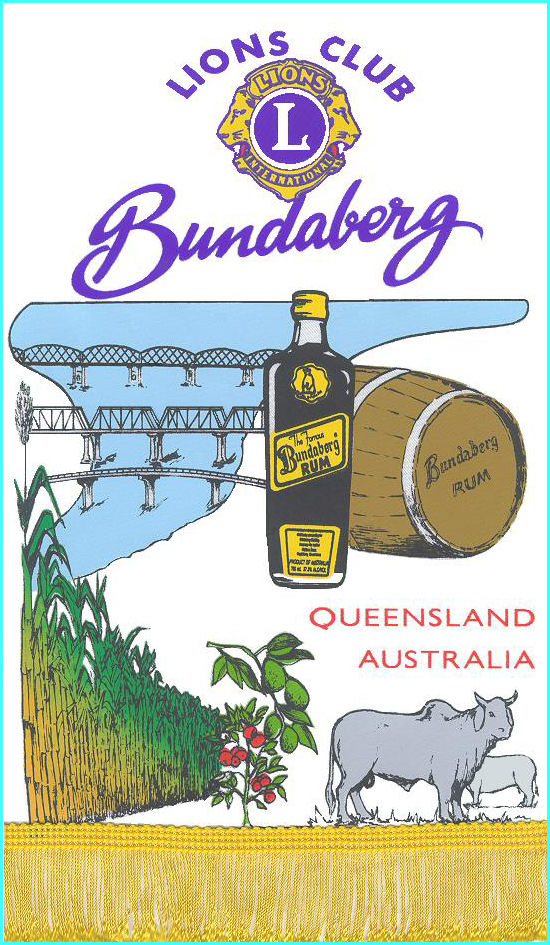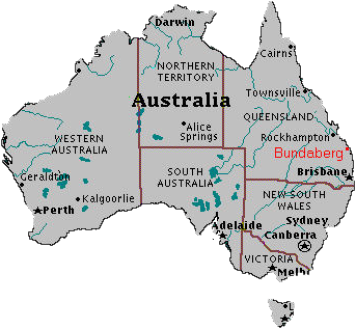In 2001 the remaining Bundaberg Lions Ladies Auxiliary was presented James D Richardson by Bundaberg Lions Club for their many years of fundraising.
Like a lot of kids who grew up in the 1980s, my wardrobe consisted of hand-me-downs or clothes handmade by my Mum; even special-occasion dresses were lovingly sewn. Clothes bought from a shop were reserved for birthday gifts, and only by special request.
Living in Childers, a trip into Bundaberg often meant a stop at a fabric store, or three. These were never quick and, in hindsight, probably not fun for Mum with three complaining kids in tow.
My childhood photo albums are a time capsule of Mum’s DIY sewing projects. The poodle skirt complete with poodle applique at the bottom; the crazy colours and patterns; the matching co-ordinate sets she would make every year for my siblings and I to model at our school’s annual fashion parade (pictured). It was these special memories that flooded back when the Crush Magazine team started planning the content for the Style Issue. It was a rabbit hole, which led us to Fashion Fantasia. I could have sworn I walked the Fashion Fantasia catwalk at least once, but Mum doesn’t remember and I can’t be sure.
For almost three decades, Fashion Fantasia was a highlight on Bundaberg’s social calendar. In this Style Issue of Crush Magazine we look back at one of the city’s most iconic events, 20-years after its final curtain.
DESIGNER
OF THE YEAR
WINNERS
1974 Cynthia Hoogstraten
1975 Cynthia Hoogstraten
1976 Cynthia Hoogstraten
1977 Jennie Herrod
1978 James Sankowsky
1979 Elaine Jensen
1980 Annette Blair
1981 James Sankowsky
1982 James Sankowsky
1983 Annette Blair
1984 Leanne Russell and
Narelle Curd
1985 Jacqui Dahl
1986 Terri Lee Trost
1987 Annette Blair
1988 Rhonda Modolo
1989 Joanne Santalucia
1990 Shirley Lucke
1991 Dwayne Blair
1992 Lynda Zunker
1993 Lynda Zunker
1994 Meena La Fien
1995 Tony Steindl
1996 Tony Steindl
1997 Val Cordon
1998 Michelle Moreno
1999 Lynda Zunker
2000 Lynda Zunker
2001 Lynda Zunker
When you talk to anyone who was part of Fashion Fantasia, there is one name that comes up again and again – Eva Anderson.
Indisputably the driving force behind the event’s successful 28-year run (1974 – 2001), Eva talks proudly of what the Ladies Auxiliary of the Bundaberg Lions Club achieved, raising more than $150,000 for local charities.
The idea of Fashion Fantasia was simple. Clothing designers and seamstresses could enter their unique work in one of eight sections. Other special awards, including Designer of the Year, were awarded on the night. A basic pattern was able to be used, but maximum points were given for originality in the design.
Drawing entries from across Queensland, the hand-crafted creations were showcased at an annual fashion parade at Bundaberg Civic Centre, attracting more than 800 spectators.
“We used to pre-sell a lot of the tickets outside Charlton, Muller and Jones on Quay Street (now Charltons Lawyers). One year we sold 650 tickets in one morning,” Eva said.
“People were lined up from 5am because they knew where they wanted to sit. I couldn’t understand why they were there so early with their chairs and their pillows.”
Eva can’t quite remember where the original idea came from, but the drive to continue year after year was altruistic.
“It was all about making money for the Lions Club. And the greatest thing, the happiest thing of all, is when we got the money in from the event and could give it all out to local charities like health and aged care services, Meals On Wheels, Lifeline and the SES (State Emergency Service).”
In 1995 Fashion Fantasia became accredited as a Regional RAQ (Retailers Association Queensland) Fashion Design Awards. This meant the major prize winner was granted automatic entry into Queensland’s biggest fashion event.
While Fashion Fantasia ended in 2001, the event continued for another year or two under the Style Spectacular banner, run by the Inner Wheel Club of Bundaberg Sunset Rotary, before folding for good.
Eva Anderson (pictured) still has scrapbooks and records about Fashion Fantasia.
Annette Blair often made her dresses (some pictured here) for the event.
DESIGNER GOWNS
For attendees, Fashion Fantasia was a great social event, but for many of the entrants it was a creative expression and the start of life-long careers.
Cynthia Hoogstraten was just 17-years-old when she entered the very first Fashion Fantasia in 1974 and won Designer Of The Year. She won again in 1975 and ’76. “I entered mainly from my mother’s encouragement,” Cynthia said. “She gave me a little sewing machine. I didn’t have a job, so I made that first winning outfit from calico because it was the cheapest fabric that I could work with. I was very feminine and loved lace, so I added that in to create lovely circles.” Inspired by the fashions of the time, each of Cynthia’s entries was different to the last. From there, Cynthia started modelling and worked in a Sunshine Coast clothing factory. She experimented with her own fabrics, creating textiles and wearable art.
Lynda Zunker took out the top accolade a record five times. Her creations were born from a love of fabrics. “I never designed a gown or garment unless I saw a fabric,” Lynda said. “I’m not a great artist. I still can’t draw a design; they are all in my head. When I found a fabric I knew exactly what I wanted to do with it. I used to make a lot of my designs out of curtain material, because that’s where you see a lot of flowers, and I had a thing for flowers.” Lynda was well-known for her beautiful formal and wedding gowns that she would create for local women. While she doesn’t sew as much as she used to, she is excited to be making her granddaughter’s prom dress in 2023.
THE FABRIC OF TIME
Arguably just as much of an icon in Bundaberg as Fashion Fantasia, Baxter’s was the city’s leading fabric store. While many fabric stores came and went (the last notable one was Bonnie Jeans), none evoke more nostalgia than Baxter’s.
Tanya Chapman worked at Baxter’s for nine years, from the time she was 16-years-old, before going on to start her own resortwear fashion label, Jotae, in 1993. “We sold to everyone, from up-and-coming fashion designers to mums making school uniforms or sewing something unique for their families,” Tanya said. “The fabrics we kept at Baxter’s were very different to some of the other stores in town at the time.”
Located at 67 Bourbong Street (next to what is now The Hut Menswear), Baxter’s was known for its impressive window displays and large range of formal fabrics. “Whenever you had a wedding party, that would take hours from a sales point of view,” Tanya said. “They would be picking their fabrics then working out all the accessories. We kept those too, down to the tiaras, veils, and gloves.” She said one of the most enjoyable parts of the job was styling mannequins in the shopfront windows, with fabrics and seasonal props, all hand made by Tanya.
KEEPING UP WITH THE JONES’S
Bourbong Street in the 1970s and ‘80s was very different from what it is now. Shopping was a special outing. And, yes – we even had department stores. It was a time when parcels were wrapped in paper and tied with string, and you could find everything you needed in just one shop. Across multiple floors were furniture, soft furnishings, fabrics, clothing, cosmetics and music, through to grocery and deli items.
Long-time locals remember when the Dimmey’s building, opposite Chemist Warehouse, was John Black’s department store, which became Reid’s and then Wyper Brothers. Many think it then became Buss and Turner, forgetting the decade it was actually a David Jones department store.
Olsen’s Corner Foodworks deli manager Lyn Jeffery worked at David Jones for ten years. Despite this fact, many people still try to tell her Bundaberg was never home to the iconic department store. “It was just like you used to see in the big cities. It was a very upmarket store with all the high-quality perfumes. It was all quality brands throughout the store, no cheapness whatsoever, right down to the chocolates,” Lynn said. “The decorations were just outstanding. Everything had to be highly-decorated and beautifully done.”
Menswear store Buss and Turner, which was established in 1876 and located next door, bought out David Jones and expanded to become a full department store. Buss and Turner ceased trading in 2000.
Cynthia Hoogstraten took out the top accolade at Fashion Fantasia, designer of the year, for the first three years.
Winner 1976
Designer of the Year Cynthia Hoogstraten
Winner 1974
Designer of the Year Cynthia Hoogstraten
Winner 1975
Designer of the Year Cynthia Hoogstraten
Winner 1999
Designer of the Year Lynda Zunker,
modelled by
Casey James
Winner 2001
Designer of the Year Lynda Zunker, modelled by Casey James
SECRET TO success
You can tell from the way Fashion Fantasia organiser Eva Anderson speaks, the iconic event was run with a firm hand. It had to start on time and finish at a decent hour. When the judges began taking too much time with their deliberations, the event moved to a pre-judged format. Eva also insisted it had to be inexpensive to attend.
Eva said it was a monumental collaboration that worked because everyone played their part, but the success didn’t come easy. Spectators spent liberally on raffle tickets. Businesses donated generously. And the committee worked incredibly hard.
“Most of the shops in town were kind to us, because we gave them as much publicity as we could. We wouldn’t have raised as much as we did if we didn’t have the backing of local business. We got everything for free,” Eva said. “When I look back on it, it was a lot of work. We had barely tidied up and people were speaking to me about the following year’s event and I was booking the Civic Centre once again. I would get phone calls at all times of the day, some at 11pm.”


